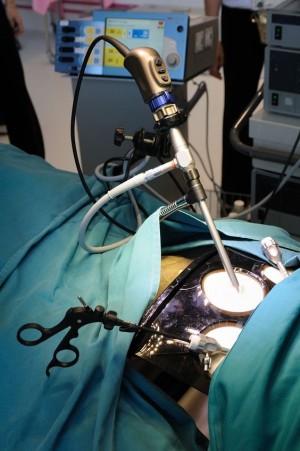Gone are the days when a revolutionary surgical procedure that boasts of shorter recovery time for patients are taught in tents and makeshift operating theaters.
Now doctors, nurses and other medical professionals who want to learn more about minimally invasive surgery (MIS), also known as laparoscopy, can do so in a facility, specially dedicated to teaching how to properly do the procedure.
The Cardinal Santos Medical Center in San Juan City recently opened the five-story Philippine Center for Advanced Surgery (PCAS), which is the first facility primarily devoted to teaching how to perform MIS to surgeons.
Dr. Alfred Allen Buenafe, executive director of the MIS Training Center of the PCAS, said the center will provide surgeons a cheaper means to learn MIS.
“There’s certainly great interest in MIS here in the Philippines. But before, many years ago, if you want to learn how to do the procedure, you would have to attend trainings abroad, of which basic courses cost about $1,000 to $2,000 and advanced courses cost $5,000. If you want to practice your skills, you need to pay more. And if you add your airfare and lodging costs, it’s about four to five times higher than the price of trainings here in the PCAS,” Buenafe said.
Makeshift theater
Buenafe and other surgeons advocating MIS have also been conducting training sessions for other budding doctors and surgeons, but they never had such a “home” like the PCAS.
“Before, in the early 1990s, we would set up a tent at the garage of the Cardinal Santos Medical Center, which we would use as a makeshift operating theater. Or we would convert a convention room that we used yesterday as a lecture room into a mock operating room, with the tables we used to help us take down notes now the operating table and with an animal as patient,” he added.
Buenafe said MIS has been the standard operating procedure for operations in the stomach and throat region, for example, for quite some time.
Unlike open surgeries, where surgeons cut huge swathes of skin to open the body and look for the part that needs surgery, MIS involves cutting small holes into the skin where a camera and other operating instruments go in.
“The benefits are huge. Compared to open surgery, minimally invasive surgery poses less risk of infection, has a shorter recovery time for patients, and costs less for them when all things are considered,” Buenafe said.
“If you go through open surgery for hernia or gall stone removal, you would normally need two to three months of rest before you can go back to work. But with MIS, patients can be discharged from the hospital just 24 hours after the operation and can get back to work after two to three days,” he added.
20 percent undergo MIS
Even at present, Health Undersecretary Teodoro Herbosa and Buenafe said that based on PhilHealth claims of patients needing surgery, only 20 percent undergo MIS, with the rest resorting to open surgery.
“But we hope that will gradually change, as the DOH [Department of Health] has been actually putting laparoscopic machines in 30 of 70 of our hospitals. And with this center, the government can send doctors to train here on minimally invasive surgery,” Herbosa said.
Buenafe and Herbosa agreed that the facilities at the PCAS are “world class,” a big improvement from just practicing in makeshift laboratories. Now, medical professionals can train in a “dry laboratory,” which uses virtual simulation to train skills, and a “skills laboratory,” where they can practice on live animal tissue.
There is also a 60-seater lecture room and a 140-seater auditorium for lectures and other events. And these lectures and even surgeries can be beamed to other hospitals nationwide, so other experts can learn remotely.
Buenafe said the center will put up regular trainings for basic laparoscopy and advanced procedures, which will be open to doctors all over the country and even nurses who want to learn how to assist in such medical procedures.
The trainings started with over 70 participants from around the country marveling at the PCAS facilities.
“It has been our dream to put this up for the past two decades. Now it has come true,” Buenafe said.
